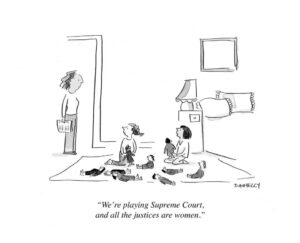 A toy can be used in any number of ways, according to the imagination of the player.
A toy can be used in any number of ways, according to the imagination of the player.
- I have seen kids who were not allowed to own toy guns pick up a twig and start shooting with it: Pew! Pew! Pew! (I understand the impulse to keep toy guns out of the hands of children, but I’ve never seen it attain its objective.)
- Regardless of what Mattel might have believed, for some of us Barbie wasn’t an aspirational toy. I used my Barbies to populate the elaborate cities and houses I constructed out of blocks and other toy box flotsam, and to serve as models for my inept attempts at clothing design.
- A friend’s daughter repurposed the highly detailed and elaborate play kitchen her grandparents gave her to be a library, with herself as the librarian (this is a child after my own heart).
Where am I going with this? Well, after three years I have succumbed, and spent a week watching all three seasons of Bridgerton. I had been told repeatedly that I would love it: since I started out as a writer publishing Regency romances–Bridgerton, which is set in an alternate version of the English Regency, should be right up my road, right? Kinda? Maybe? No?
Well, kinda, in the sense that Bridgerton is entertaining. But also no, because I was left wondering why, out of all the toys available to them, the show’s creators decided to play with the English Regency. Granted, the books upon which the series is based is set in the period, so there’s that. But, especially as the series goes on, the creators seem to have less and less interest in having the series take place in that then-and-there. In the first season the clothes and manners are relatively on target (for Hollywood values of on target) but by the third season the underlying message seems to be “well, that was too much work, we didn’t like the constraints, who cares anyway.” And of course, I care.
Bridgerton (if you are the sole human who has not seen any part of it) is set in the English Regency, in an alternate world in which Queen Charlotte, the consort of George III, is a woman of color (if there’s a backstory to how that happens it eluded me), and her marriage into the British royal family has expanded the position of people of color at all levels of society. This is a nifty setup, and it’s one of the things that the show’s creators play with: some of the characters bear scars of an earlier time when persons of color, while evident, were not accepted into the Ton (read: high society). I frankly wish there’d been a little more of that in the show.
What there is a whole lot of is sex: Shonda Rimes, who is the executive producer and apparent guiding genius behind Bridgerton (although the “created by” credit goes to Chris Van Dusen, based on the novels by Julia Quinn) was the producer of Grey’s Anatomy; she’s known for sex-positive soap opera (in the sense that the emotional lives of characters are very much front and center) with a special interest in feminism. Bridgerton is clearly a fairy tale: aside from one inconvenient pregnancy for a secondary character in the first season, there appears to be no unpleasant sequelae to all this boinking (the Bridgerton boys have a lot of sex with a lot of women before they settle down to True Love, and yet no one contracts syphilis, which was everywhere). And the fact that two of those True Loves have premarital sex (granted, the sex is with the Bridgerton son each one marries) drove me crazy.
I stopped writing romances in the 1980s precisely because of this sort of (with apologies to Erica Jong) “zipless fuck” plotting. If you want to set something in the past–even an alternate version of the past–that has rules and stipulations and corsets and history, you can’t just decide, six chapters in, that none of the rules or stipulations or corsets matter if they’re going to get in the way of the sex. When the rules are only there as a way of signaling to the reader or watcher that Our Heroine has been swept on a tide of passion past all sensible constraints–well, they aren’t really rules, they’re just props.
Why not set the story in the Duchy of Pflugh, where you can invent easier rules? Fewer corsets? Younger sons who have enough of a fortune that they don’t have to join the army or the clergy?
This post is remarkably hard for me to write, because I want to keep citing the distance between the real Regency and Bridgerton: there’s that! and another thing! And another! And that, and that! But after a lot of thought I’ve realized that the creators of Bridgerton took a stick, or a Barbie, or a Playskool Kitchen, and decided to use it in a way that is very different from the way I would use them.
Which is fair. Bridgerton is a brightly colored, highly scented pretend play with a passing resemblance to England and the early 19th century. And for most people that’s all they want. In fact, when I think of Bridgerton as an Adjacency romance (rather than a Regency romance) it goes down much easier.
There’s a lot to like about the show: it’s fast, it’s pretty, there are some good performances, and some totally over the top set-pieces (the rotating bandstand in the middle of a ballroom distracted me into wondering how they would have pulled that off using the technology of the time). Everyone seems to be having a great time, and the show offers a distinctly feminist view of what being a heroine of a romance can be. The women have–or at least reach for–agency.
It’s intriguing to see how someone else wants to do it, but I think I’ve seen enough. There will be more seasons of Bridgerton, but me? I will go back to playing with my Barbies the way I like.
